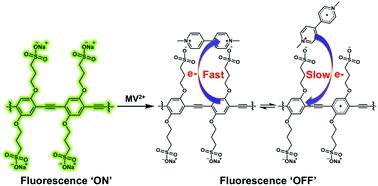当前位置:
X-MOL 学术
›
Mater. Chem. Front.
›
论文详情
Our official English website, www.x-mol.net, welcomes your
feedback! (Note: you will need to create a separate account there.)
Ultrafast photoinduced electron transfer in conjugated polyelectrolyte–acceptor ion pair complexes
Materials Chemistry Frontiers ( IF 6.0 ) Pub Date : 2020-09-18 , DOI: 10.1039/d0qm00476f Pradeepkumar Jagadesan 1, 2, 3, 4, 5 , Silvano R. Valandro 1, 2, 3, 4, 5 , Kirk S. Schanze 1, 2, 3, 4, 5
Materials Chemistry Frontiers ( IF 6.0 ) Pub Date : 2020-09-18 , DOI: 10.1039/d0qm00476f Pradeepkumar Jagadesan 1, 2, 3, 4, 5 , Silvano R. Valandro 1, 2, 3, 4, 5 , Kirk S. Schanze 1, 2, 3, 4, 5
Affiliation

|
Conjugated polyelectrolytes (CPEs) are a promising class of materials for photovoltaic and sensing applications due to their ability to undergo efficient photoinduced electron transfer (ET). Although water-soluble poly(p-phenylene ethynylene) (PPE) polyelectrolytes have been synthesized for various applications, no reports have clearly revealed the dynamics of the photoinduced ET process and charge transfer state of PPE-type CPE/electron acceptor systems. Herein, we investigated photoinduced ET from a water-soluble PPE based CPE functionalized with alkyl sulfonate (R–SO3−) as side groups to three cationic electron acceptors. Steady-state absorption studies showed a bathochromic shift of the absorption band for all CPE/acceptor mixtures compared to CPE as a result of the suppression of the conformational changes in the polymer caused by the ion–pair interaction. Stern–Volmer (SV) fluorescence quenching studies revealed that all of the cationic electron acceptors efficiently quenched the fluorescence of CPE with SV constants (KSV) in excess of 106 M−1. Picosecond transient absorption (TA) studies of a CPE/methyl viologen mixture revealed the absorption feature of the cation radical state (CPE˙+) of the polyelectrolyte. Kinetic measurements established that the forward electron transfer in the polyelectrolyte/acceptor mixtures occurs with rate constant kf > 1 × 1012 s−1 and the return ET occurs with kb = 3 × 1011 s−1. We also demonstrated that the electron transfer between a PPE-type polyelectrolyte and an acceptor in their assemblies could be modulated by a supramolecular approach, which revealed that the nature of the acceptor–supramolecule host–guest complexes dictates the kinetics of the electron transfer process.
中文翻译:

共轭聚电解质-受体离子对复合物中的超快光诱导电子转移
共轭聚电解质(CPE)由于具有进行有效的光致电子转移(ET)的能力,是用于光伏和传感应用的有前途的一类材料。尽管已经合成了水溶性聚对苯撑乙炔(PPE)聚电解质用于各种应用,但是没有报道清楚地揭示出光诱导的ET过程的动力学和PPE型CPE /电子受体体系的电荷转移状态。在本文中,我们研究了从与烷基磺酸盐(R-SO官能化的水溶性PPE基于CPE光敏反应ET 3 -作为侧基,以三种阳离子电子受体)。稳态吸收研究表明,所有CPE的吸收带发生红移/受体混合物与CPE相比,是由于抑制了离子对相互作用引起的聚合物构象变化。Stern-Volmer(SV)荧光猝灭研究表明,所有阳离子电子受体均能有效地猝灭CPE的荧光,其SV常数(K SV)超过10 6 M -1。一个的皮秒瞬态吸收(TA)的研究CPE /甲基紫精混合物揭示阳离子自由基状态(的吸收特征CPE ˙ +)。动力学测量确定,聚电解质/受体混合物中的正向电子转移发生在速率常数k f > 1×10 12 s -1,返回ET发生在k b = 3×10 11 s -1。我们还证明了PPE型聚电解质和其组装体中受体之间的电子转移可以通过超分子方法来调节,这表明受体-超分子主体-客体复合物的性质决定了电子转移过程的动力学。
更新日期:2020-11-03
中文翻译:

共轭聚电解质-受体离子对复合物中的超快光诱导电子转移
共轭聚电解质(CPE)由于具有进行有效的光致电子转移(ET)的能力,是用于光伏和传感应用的有前途的一类材料。尽管已经合成了水溶性聚对苯撑乙炔(PPE)聚电解质用于各种应用,但是没有报道清楚地揭示出光诱导的ET过程的动力学和PPE型CPE /电子受体体系的电荷转移状态。在本文中,我们研究了从与烷基磺酸盐(R-SO官能化的水溶性PPE基于CPE光敏反应ET 3 -作为侧基,以三种阳离子电子受体)。稳态吸收研究表明,所有CPE的吸收带发生红移/受体混合物与CPE相比,是由于抑制了离子对相互作用引起的聚合物构象变化。Stern-Volmer(SV)荧光猝灭研究表明,所有阳离子电子受体均能有效地猝灭CPE的荧光,其SV常数(K SV)超过10 6 M -1。一个的皮秒瞬态吸收(TA)的研究CPE /甲基紫精混合物揭示阳离子自由基状态(的吸收特征CPE ˙ +)。动力学测量确定,聚电解质/受体混合物中的正向电子转移发生在速率常数k f > 1×10 12 s -1,返回ET发生在k b = 3×10 11 s -1。我们还证明了PPE型聚电解质和其组装体中受体之间的电子转移可以通过超分子方法来调节,这表明受体-超分子主体-客体复合物的性质决定了电子转移过程的动力学。











































 京公网安备 11010802027423号
京公网安备 11010802027423号